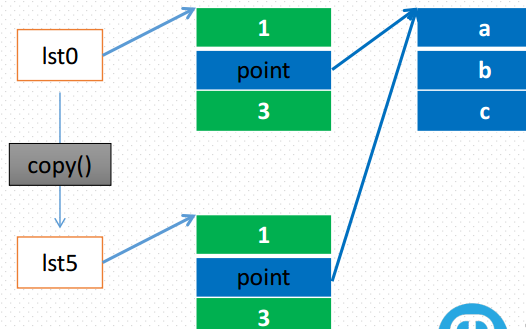1、python数据结构分类
(1)常规分类:
数值型:int、float、bool
序列对象:list、str、tuple
键值对:dict
(2)根据可变与不可变分类:
# 什么是可变?什么又是不可变?
一般变量都会有三个属性:id,type,value;
这里id与type不变,值改变则为可变数据类型;value改变,id就改变为不可变;
不可变:数字,字符串,tuple
可变:list,dict
(3)按照访问顺序区分
直接访问:数字
顺序访问:字符串,列表,元组
key值访问:字典
2、python之数字处理
2.1、round()函数
# 四舍六入,五取最近偶数
print(round(3.5)) # 4 print(round(1.5)) # 2 print(round(4.5)) # 4
# 只有小数刚刚为:.5的时候是取最近偶数,如果超过5则为6入了,例如 round(2.51) 结果为3;
2.2、math模块:floor()与ceil()
floor() ==> 地板(向下取值)
ceil() ==>天花板(向上取值)
import math print(math.floor(1.5)) # 向下取值为1 print(math.ceil(1.5)) # 向上取值为2 print(math.ceil(-1.5)) # 向上取值为-1 print(math.floor(-1.5)) # 向下取值为-2
2.3、int()与//
# int取整,//整除并且向下取整
1 print(10//3) ==》3 2 print(int(3.33)) ==》3
2.4、min()、max()函数
def max(*args, key=None): # known special case of max """ max(iterable, *[, default=obj, key=func]) -> value max(arg1, arg2, *args, *[, key=func]) -> value
==================================================>
# max(1,3,5) ==>5
# max([1,3,4]) ==>4
2.5、pow()与math.sqrt()
1 # pow(x,y) ==>x**y 2 pow(2,3) ==>8 3 4 # math.sqrt(x) ==>return float ===> x**0,5 5 math.sqrt(100) ==> 10.0
2.6、进制转换函数
1 print(bin(12)) # 10进制转二进制 0b1100 2 print(oct(12)) # 10进制转八进制 0o14 3 print(hex(12)) # 10进制转十六进制 0xc
2.7、类型判断函数
# type(object) -> the object's type print(type(12)) ==》 <class 'int'> # isinstance(obj, class_or_tuple, /) A tuple, as in ``isinstance(x, (A, B, ...))`` print(isinstance([123,23],(int,str))) # Fasle
3、python之列表
3.1、list列表的特点
(1)列表在内存空间中表现是一段连续并且有序的地址空间,是一种线性的数据结构;
(2)列表中的个体被称为元素,由若干个元素组成列表;
(3)元素可以是任意对象(数字,字符串,列表,字典等)
(4)列表中的元素根据索引号,顺序排列,可以通过索引号访问元素;
(5)列表是可变的数据类型;
3.2、列表,链表,queue,stack的差异
# 列表和链表在内存中都是一种有序的线性的数据结构;
# 不同的是列表是必须为连续的一段地址空间,通过索引的偏移量访问;而链表内存可以不连续,前一个空间只向后一个空间;
(1)链表与列表的优缺点?
# 列表由于必须是连续有序,所以列表的访问速度比较快,在不改变原来结构的情况下append数据也还可以,总结:列表访问快,修改慢;
# 链表的特点是上一个空间指向下一个空间,即如果要插入一个元素,只需要修改前后2个元素的空间指向即可,如果要访问,则需要遍历元素;总结:链表修改快,访问比较满;


# 队列(queue)与栈(stack)
队列特点:先进先出,类似于管道;list.pop(0)可以模拟
栈特点:后进先出,类似于子弹夹;list.pop()可以模拟
3.3、列表定义与初始化
def __init__(self, seq=()): # known special case of list.__init__ """ list() -> new empty list list(iterable) -> new list initialized from iterable's items # (copied from class doc) """
# list() 等于 l=[] 创建一个空列表
# list(iterable) ==> iterable 为一个可迭代对象, list(range(5)) 等于 l=[0,1,2,3,4]
3.4、列表索引访问
# 索引,也称为下标
# 正索引:从左至右,从0开始;负索引:从右到左,-1开始(最后一个元素);
# 访问索引不能越界,不然会报错IndexError
1 l=['a','b','c','d','e'] 2 3 ''' 4 # 格式:[start:end:step] 5 [:] 提取开头(默认位置0)到结尾(默认位置-1)的整个字符串; 6 [start:] 从start位置提取到结尾 7 [:end] 从开头提取到end-1 8 [start:end] 从start到end-1 9 [start:end:step] 从start到end-1,每step个字符提取一个 10 ''' 11 # [:] 提取开头(默认位置0)到结尾(默认位置-1)的整个字符串; 12 print(l[:]) # ==> ['a', 'b', 'c', 'd', 'e'] 13 # [start:] 从start位置提取到结尾 14 print(l[1:]) # ==> ['b', 'c', 'd', 'e'] l[0]=a 没有打印 15 # [:end] 开头提取到end-1 16 print(l[:4]) # ==> ['a', 'b', 'c', 'd'] l[4]=e 没有打印 17 # [start:end] 从start到end-1 18 print(l[1:4]) # ==> ['b', 'c', 'd'] l[0],l[4] 没有打印 19 # [start:end:step] 从start到end-1,每step个字符提取一个 20 print(l[0:5:2]) # ==>['a', 'c', 'e']
3.5、列表查询
# list.index(value,[star,[stop]])
''' index(...) L.index(value, [start, [stop]]) -> integer -- r Raises ValueError if the value is not present. # 通过值value,从指定的区间查找列表内的元素是否匹配,匹配到第一个则返回索引号;匹配不到则报错ValueError ''' print(l.index('a',0,4)) # ==>0 在列表0到4之间匹配字符'a',匹配到则返回index号0;
# list.count(value) ==>返回列表中匹配value的次数
# 注意:index和count方法的时间复杂度都是O(n),n为列表的规模,随着规模越来越大,则效率越来越慢;
3.6、列表元素修改
# list[index]=value ==>直接对索引位置元素进行赋值(覆盖原来元素)
#### 给列表增加元素的方法#####
# append方法 append(self, p_object) """ L.append(object) -> None -- append object to end """ # insert方法 insert(self, index, p_object) """ L.insert(index, object) -- insert object before index """ # extend方法 extend(self, iterable) """ L.extend(iterable) -> None -- extend list by appending elements from the iterable """
## 删除元素方法 pop方法 pop(self, index=None) """ L.pop([index]) -> item -- remove and return item at index (default last). Raises IndexError if list is empty or index is out of range. """ remove方法 remove(self, value) """ L.remove(value) -> None -- remove first occurrence of value. Raises ValueError if the value is not present. """
# '+' ==> list
连接操作,将2个列表连接起来
产生新的列表,原列表不变,本质上是调用了__add__()方法;
# ‘*’ ==> list
重复操作,将本列表元素重复n次,返回新的列表;
# 关于*的坑 # 当列表内的元素为数值类型是,*则为简单的重复 l1=[1,2,3] # # print(l1*3) # ==> [1, 2, 3, 1, 2, 3, 1, 2, 3] # 当列表内有引用数据类型的时候,* 则是复制的引用类型的内存地址; l2=[1,2,3,l1] l3=l2*3 print(l2) print(l3) print('<==================================>') l2[3][0]=10 print(l3) ''' [1, 2, 3, [1, 2, 3]]
[1, 2, 3, [1, 2, 3], 1, 2, 3, [1, 2, 3], 1, 2, 3, [1, 2, 3]]
<==================================>
[1, 2, 3, [10, 2, 3], 1, 2, 3, [10, 2, 3], 1, 2, 3, [10, 2, 3]] '''
3.7、列表的拷贝
# 深拷贝(deepcopy)与浅拷贝(show copy,默认为浅拷贝)
# 浅拷贝图解:

# 深拷贝:实际是把指针的内容也拷贝了一份,拷贝的point和原来的point指向不同的内存空间了;
# 实现深拷贝需要单独导入copy模块才能使用:copy.deepcopy(object)
3.8、列表排序,反转
# reverse() 返回None,将列表元素反转 (返回None,表示直接修改原列表,不会产生新列表)
# sort(key=None,reverse=False) 返回None,默认为升序排列;
1 l=[2,354,3,1,78,122] 2 l.sort() 3 print(l) 4 ''' 5 [1, 2, 3, 78, 122, 354] 6 '''
3.9、随机数
# 导入random模块
1 import random 2 3 # print(random.randint(0,1)) # 返回[a,b]之间的整数 4 L=[1,2,3,4] 5 # print(random.choice(l)) # 从非空序列的元素中随机挑选一个元素 6 print(random.randrange(1,7,2)) 7 random.shuffle(L) # 对列表L进行洗牌操作 8 print(L) # ==> [3, 2, 4, 1] 9 10 ''' 11 sample(self, population, k) 12 population:样本空间; 13 k:取值个数 14 ''' 15 print(random.sample(L,2)) # 表示从列表L中随机挑选2个数输出 ==> [4, 2]